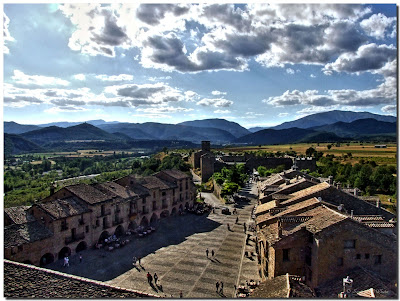via UrbanTick
The origin of cities has been subject of an earlier post with a clear focus on cycles. For an additional post here the starting point is quite a different one. It is the book History of Urban Form - Before the Industrial Revolutions“ by A.E.J. Morris in the third edition. A book of facts and old school history, interpreting the subject rather functional and with a pretend objectivity.
However it is a very popular book and as the third edition demonstrates, able to maintain its popularity over more than twenty years. The first edition was published in 1972.
From the book by Josef H. Reichholf titled “Warum die Menschen sesshaft wurden” the idea of rites and routines where directly involved in the creation of the first settlements and later the creation of the city. In the HUF (History of Urban Form) is acknowledging that the early history of human settlements is still being written, the description blurs early cities/settlements into early cultures such as Aztecs, Maya, Egyptian/Mesopotamia, Greek/Roman or Islamic culture. However, the description in the book starts much earlier in the human history, somewhere in the Neolithic Age when humans are believed to be, in the words of the publication “...on much the same basis as any of the other animals, by gathering naturally occurring foodstuff...” (p 3). Fro this assumed nomadic life (I am not sure this would not necessarily imply a nomadic live, some animals do live a territorial life) the humans moved on, around 14000 BC to live in caves. Suddenly, settling is possible, but I assume this is what the archeological evidence is telling us. This is presented a shift in the concept of living, an improvement over the nomads to settle down in a cave. The logical step to follow this shift is the cultivation of plants around 8’000 to 10’000 years ago and successive the domestication of animals. Logic because it is believed that a settled live would make it necessary to source food locally and this food stock would need to be maintained through out the year. This is then famously described “The escape from the impasse of savagery was an economic and scientific revolution that made the participants active pattern with nature instead of parasites on nature” (by Childe? in What Happened in History)
However it is a very popular book and as the third edition demonstrates, able to maintain its popularity over more than twenty years. The first edition was published in 1972.
From the book by Josef H. Reichholf titled “Warum die Menschen sesshaft wurden” the idea of rites and routines where directly involved in the creation of the first settlements and later the creation of the city. In the HUF (History of Urban Form) is acknowledging that the early history of human settlements is still being written, the description blurs early cities/settlements into early cultures such as Aztecs, Maya, Egyptian/Mesopotamia, Greek/Roman or Islamic culture. However, the description in the book starts much earlier in the human history, somewhere in the Neolithic Age when humans are believed to be, in the words of the publication “...on much the same basis as any of the other animals, by gathering naturally occurring foodstuff...” (p 3). Fro this assumed nomadic life (I am not sure this would not necessarily imply a nomadic live, some animals do live a territorial life) the humans moved on, around 14000 BC to live in caves. Suddenly, settling is possible, but I assume this is what the archeological evidence is telling us. This is presented a shift in the concept of living, an improvement over the nomads to settle down in a cave. The logical step to follow this shift is the cultivation of plants around 8’000 to 10’000 years ago and successive the domestication of animals. Logic because it is believed that a settled live would make it necessary to source food locally and this food stock would need to be maintained through out the year. This is then famously described “The escape from the impasse of savagery was an economic and scientific revolution that made the participants active pattern with nature instead of parasites on nature” (by Childe? in What Happened in History)
 |
Main square / Plaza mayor, photo by . SantiMB . |
more posts about urban history:
No comments:
Post a Comment